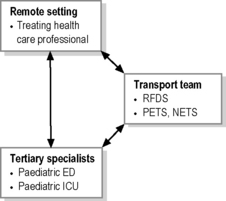27.2 Sick child in a rural hospital
Challenges in the rural setting
Caring for the critically ill child
Potential problems to the stabilisation the child
Conversely, from the perspective of the receiving tertiary unit, it is important to offer ongoing advice and support, and to help plan and facilitate the transfer by liaising supportively with the transferring team (Fig. 27.2.1).
What can be done to assist care in remote environments?
Transport
In some cases, even the above consultation system will not enable the child to be managed at the rural hospital, and specialist care at a paediatric hospital will be needed. A centrally located paediatric triage and retrieval service, staffed by nurses and doctors with training and experience in triage and paediatric retrieval (see Chapter 27.1) can transfer severely ill and unstable patients to an urban tertiary hospital.
Australian Institute of Health and Welfare. Australia’s health 2008. Canberra: AIHW; 2008. Cat. no. AUS 99
Australian Institute of Health and Welfare. A picture of Australia’s children 2009. Canberra: AIHW; 2009. Cat. no. PHE 112
Australian Institute of Health and Welfare. Medical Labour Force 2007. In National Health Labour Force Series no. 44. Canberra: AIHW; 2009.
. Emergency Medicine in Rural Australia. Submission to DoHA by the Rural Doctors Association of Australia. 2007. Available from: http://www.rdaa.com.au/Uploads/Documents/Emergency%20Medicine%20in%20Rural%20Australia_20101012041618.pdf [accessed 29.10.2010]
Fragar L.J., Stiller L., Thomas P. Child injury on Australian farms. Canberra: RIRDC; 2005. Rural Industries Research and Development Corporation, and Australian Centre for Agricultural Health and Safety
Goh A. Y-T., Abdel-Latif M. El-A., Lum L.C-S., Abu-Bakar M.N. Outcome of children with different accessibility to tertiary pediatric intensive care in a developing country – a prospective cohort study. Intens Care Med. 2003;29:97-102.
Marcin J.P., Nesbitt T.S., Kallas H.J., et al. Use of telemedicine to provide pediatric critical care inpatient consultations to underserved rural Northern California. J Pediatr. 2004;144:375-380.
Peake S.L., Judd N. Supporting rural community-based critical care. Curr Opin Crit Care. 2007;13:720-724.




